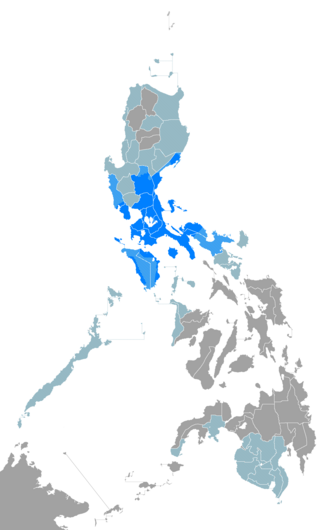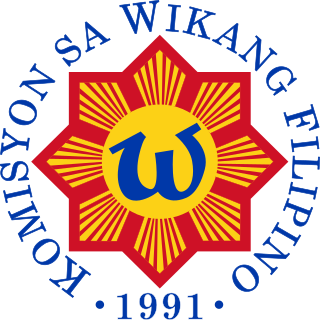Related Research Articles

Tagalog is an Austronesian language spoken as a first language by the ethnic Tagalog people, who make up a quarter of the population of the Philippines, and as a second language by the majority, mostly as or through Filipino. Its standardized, codified, national or nationalized, intellectualized, more linguistically inclusive, more linguistically dynamic, and expanded or broaden form, officially named Filipino, is the national language of the Philippines, and is one of the latter's two official languages, alongside English. Tagalog, like the other and as one of the regional languages of the Philippines, which majority are Austronesian, is one of the auxiliary official languages of the Philippines in the regions and also one of the auxiliary media of instruction therein.

Filipino is a language under the Austronesian language family. It is the national language of the Philippines, lingua franca, and one of the two official languages of the country, with English. It is a standardized variety of the native language Tagalog, spoken and written in Metro Manila, the National Capital Region, and in other urban centers of the archipelago. The 1987 Constitution mandates that Filipino be further enriched and developed by the other languages of the Philippines.
Baybayin or Sulat Tagalog, also called Basahan by Bicolanos, sometimes erroneously referred to as alibata, is a Philippine script widely used primarily in Luzon during the 16th and 17th centuries and prior to write Tagalog and to a lesser extent Visayan languages, Kampampangan, Ilocano, and several other Philippine languages.
Filipinoorthography specifies the correct use of the writing system of the Filipino language, the national and co-official language of the Philippines.

Tagbanwa is one of the scripts indigenous to the Philippines, used by the Tagbanwa and the Palawan people as their ethnic writing system.

Kapampangan, Capampáñgan, or Pampangan is an Austronesian language, and one of the eight major languages of the Philippines. It is the primary and predominant language of the entire province of Pampanga and southern Tarlac, on the southern part of Luzon's central plains geographic region, where the Kapampangan ethnic group resides. Kapampangan is also spoken in northeastern Bataan, as well as in the provinces of Bulacan, Nueva Ecija, and Zambales that border Pampanga. It is further spoken as a second language by a few Aeta groups in the southern part of Central Luzon. The language is known honorifically as Amánung Sísuan.

Maranao is an Austronesian language spoken by the Maranao people in the provinces of Lanao del Sur and Lanao del Norte and the cities of Marawi and Iligan City in the Philippines, as well as in Sabah, Malaysia. It is a subgroup of the Danao languages of the Moros in the Bangsamoro Autonomous Region in Muslim Mindanao.

The Commission on the Filipino Language (CFL), also referred to as the Komisyon sa Wikang Filipino (KWF), is the official regulating body of the Filipino language and the official government institution tasked with developing, preserving, and promoting the various local Philippine languages. The commission was established in accordance with the 1987 Constitution of the Philippines.
The modern Filipino alphabet, otherwise known as the Filipino alphabet, is the alphabet of the Filipino language, the official national language and one of the two official languages of the Philippines. The modern Filipino alphabet is made up of 28 letters, which includes the entire 26-letter set of the ISO basic Latin alphabet, the Spanish Ñ, and the Ng. The Ng digraph came from the Pilipino Abakada alphabet of the Fourth Republic. Today, the modern Filipino alphabet may also be used to write all autochthonous languages of the Philippines and Chavacano, a Spanish-derived creole.

The Tagalog Wikipedia is the Tagalog language edition of Wikipedia, which was launched on 1 December 2003. It has 47,754 articles and is the 104th largest Wikipedia according to the number of articles as of 11 November 2024.

Lope K. Santos was a Filipino Tagalog-language writer and former senator of the Philippines. He is best known for his 1906 socialist novel, Banaag at Sikat and for his contributions to the development of Filipino grammar and Tagalog orthography.

There have been several names of the Philippines in different cultures and at different times, usually in reference to specific island groups within the current archipelago. Even the name Philippines itself was originally intended to apply only to Leyte, Samar, and nearby islands. It was bestowed by the Spanish explorer Ruy López de Villalobos or one of his captains Bernardo de la Torre in 1543 in honor of the crown prince Philip, later Philip II. Mindanao, which they reached first and assumed to be the greater land, they named after the reigning emperor Charles V, who was also Spain's king Carlos I. Over the course of Spanish colonization, the name was eventually extended to cover the entire chain. It has survived with minor changes. The Philippine Revolution called its state the Philippine Republic. The US military and civilian occupations called their territory the Philippine Islands. During the Third Philippine Republic, the state's official name was formally changed to the Philippines.
Ponciano B. Peralta Pineda is a Filipino writer, teacher, linguist and lawyer. Ponciano Pineda is considered as the "Father of the Commission on Filipino Language" for his promotion to establish a commission based on Section 9 of our Philippine Constitution.
Jose Villa Panganiban was a Filipino lexicographer, writer, professor, linguist, polyglot, poet, journalist, radio personality, and translator. He was the director of the Institute of National Language. One of the first promoters and developers of the Philippine national language, he was best known for his work Diksyunaryo–Tesauro Ingles–Pilipino.

Kulitan, also known as súlat Kapampángan and pamagkulit, is one of the various indigenous suyat writing systems in the Philippines. It was used for writing Kapampangan, a language mainly spoken in Central Luzon, until it was gradually replaced by the Latin alphabet.
"Para Sa Tao" is a Philippine world music song by HUMANFOLK from their eponymous first album; composed by guitarist Johnny Alegre in 2009, and which became the group's carrier hit single. The song was arranged by keyboardist-vocalist Abby Clutario. A music video directed by Daphne Oliveros was produced for the song, and for which a radio edit was created. Both the full and radio edit versions of the song were included in the eponymous "Humanfolk" album, released in May 2011 by MCA Music.
Tagalog alphabet may refer to:
Suyat is a collective name for the Brahmic scripts of Philippine ethnolinguistic groups. The term was suggested and used by cultural organizations in the Philippines to denote a unified neutral terminology for Philippine scripts.
Reforms of Kapampangan orthography in the Latin script began with the adoption toward the end of Spanish colonial rule of an indigenized orthography. Up until then, Spanish norms were used in writing Kapampangan, which in turn meant that Kapampangan orthography was subject to the succession of reforms made by the Real Academia Española to Spanish orthography.

Buwan ng Wikang Pambansa, simply known as Buwan ng Wika and formerly and still referred to as Linggo ng Wika, is a month-long annual observance in the Philippines held every August to promote the national language, Filipino. The Commission on the Filipino Language is the lead agency in charge of organizing events in relation to the observances.
References
- ↑ ABS-CBN News (September 17, 2019). "Libreng aklat: Balarila ng Wikang Pambansa maaari nang ma-download". ABS-CBN News. Retrieved August 20, 2023.
- ↑ "Kasaysayan: Ebolusyon ng Alpabetong Filipino". PBworks. October 11, 2007. Retrieved June 22, 2010.
- ↑ Santos, Lope K. (2019) [1939]. Balarilà ng Wikang Pambansá (PDF). Manila: Aklat ng Bayan. ISBN 978-621-8064-57-7.
- ↑ Pangilinan, Michael Raymon. "Kapampángan or Capampáñgan: Settling the Dispute on the Kapampángan Romanized Orthography" (PDF). Archived from the original (PDF) on 2006-08-21. Retrieved 2010-06-21.